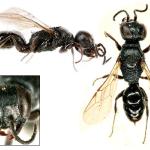Gayubo & Felton (2000) provide an identification key to the six European Nitela species, as well as detailed descriptions. Felton (1987) keyed the two British species, misidentifying N. lucens as N. spinolae.
The known distribution of this species is very restricted, ie. the extreme south-east of England, including East Sussex (I C Beavis pers. com.), West Kent and East Kent. The species is very common in northern and central Europe. It is known from Finland, The Netherlands, Belgium, Luxembourg, France, Andorra, Spain, Germany, Switzerland, Italy, Poland, Czech Republic, Austria, Hungary and Greece. Also known from Tunisia, Turkey and Azerbaijan.
Listed as Rare (RDB3) in Shirt (1987) and as Insufficiently Known (pRDBK) by Falk (1991).
Recorded in gardens and on waste ground.
Late May to late August.
Females have been captured carrying nymphal psocids (Psocoptera) as prey (pers. obs.). It is possible that the species will also prey on aphids.
The species has been found nesting in abandoned insect burrows in wooden posts and, occasionally, in small holes in old walls (pers. obs.). Hollow plant stems have also been recorded as nest sites (Lomholdt 1975-76). Males can be found running in an excited fashion around the nest sites. Females often seach for new nest sites on foot rather than by flight. Nothing further is known of the nesting biology of N. borealis. The larva was described by Valkeila (1955).
No information is available on flower visits. Specimens have been captured visiting honeydew on the foliage of cultivated roses (pers. obs.).
No information available.


